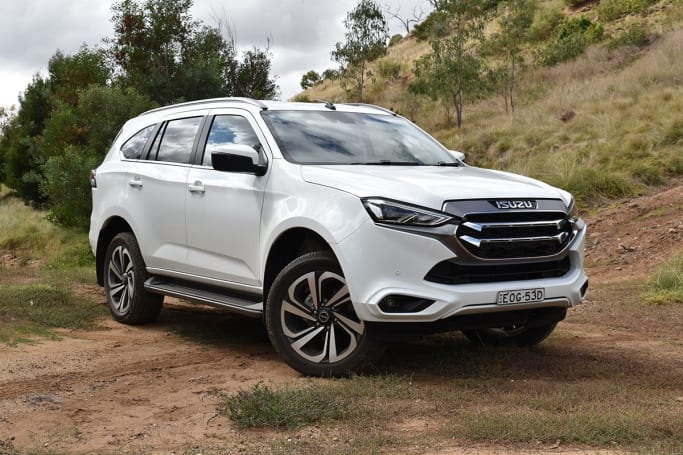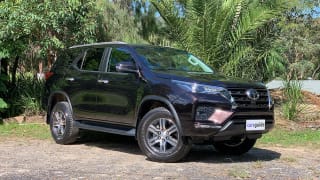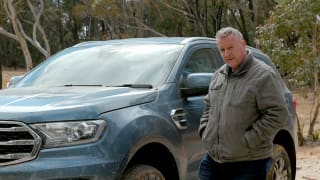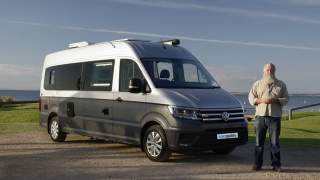Getting to know ‘U’
The first Isuzu MU-X released in 2013 proved so popular with Aussie buyers, particularly those that needed to tow things, it became the nation’s best-selling ute-derived SUV the following year. And it maintained that enviable position for the next seven years when it welcomed the arrival of the all-new second generation MU-X in mid-2021.
Together, the combined sales of old and new models last year ensured that Isuzu’s increasingly popular MU-X remained king of ute-derived SUVs, which according to VFACTS expanded its market share of the Large SUV segment from 7.7 per cent in 2020 to 9.4 per cent in 2021.
That represents sales of 10,618 examples, comfortably outselling Ford’s Ranger-derived Everest (8,359), Mitsubishi’s Triton-based Pajero Sport (6,804) and Toyota’s HiLux-derived Fortuner (3822). And if January 2022 figures are any guide, that upward sales trend looks set to continue, with sales that are roughly 50 per cent higher compared to the same time a year ago.
Fact is, since its introduction in 2013, the MU-X has built the kind of sales curve you could ski down. And clearly, if the customer is never wrong, then Isuzu must be continuing to do lots of things right with the latest one.
And given that I’ve previously tested a first-generation MU-X for CarsGuide, during a three-month loan in 2019, I was naturally keen to do the same when Isuzu Ute Australia made the all-new second-gen MU-X available in January for a longer six-month loan period in 2022.
I’m looking forward to seeing how it also performs in the dual roles of weekday family car/weekend fun machine for our family of two parents and two teenagers, including everything from grocery shopping to soccer training, bike-carrying, touring, towing, off-roading and anything else that comes our way.
According to Isuzu Ute Australia boss Hiroyasu Sato, Australia is the largest market for the MU-X outside of Thailand. As a result, the all-new model has a unique Australian specification that’s been tailored to suit our needs, guided by extensive feedback from local customers.
For example, towing and long-distance touring are fundamental Aussie requirements, with customer surveys confirming that half of all Aussie Isuzu owners tow things. That kind of feedback (and lots more) was crucial when designing the all-new MU-X, with its trailer sway control across the range and genuine accessories that include a tow-bar kit, electronic brake controller, Clearview extendable towing mirrors and for the first time a weight distribution hitch (WDH).
It’s available with either 4x2 or 4x4 drivetrains in a choice of three model grades comprising LS-M, LS-U and premium LS-T like our test vehicle. With its 3.0 litre turbo-diesel engine, six-speed torque converter automatic and 20-inch machined two-tone alloy wheels with 265/50R20 tyres and full-size alloy spare, our Mineral White 4x4 LS-T has a list price of $65,900. That’s more than premium-grade ute-derived SUV rivals including the Mitsubishi Pajero Sport GSR ($60,940) and Toyota Fortuner Crusade ($62,945) but considerably less than the Ford Everest Titanium ($73,190).
So, what’s new?
Pretty much everything except the name. The body design heralds a fresh and undeniably handsome styling direction with improved driver visibility and reduced aero drag. Dual horizontal accents in the grille, like the latest D-MAX ute, pay homage to Isuzu’s proud truck heritage in what is arguably the best-looking ute-derived SUV on the market.

Adhering to a rugged body-on-frame tradition, the new chassis and body combination is stronger and more durable with improvements in corrosion resistance, rigidity, capacity, quietness and crash safety.
The new body is constructed with twice the amount of high tensile steel and has considerably more spot welds in key areas for added strength and safety. The stronger and more rigid ladder-frame chassis derived from the latest D-MAX is constructed exclusively from high-tensile steel, with new body mountings that ensure less vibration and road noise transmitted to the heavily insulated body.
Ride and handling have been improved with new design twin-wishbone front suspension, five-link coil-spring rear suspension, electric power-assisted steering and larger brakes. It has a longer wheelbase and is longer, wider and lower overall, yet offers more ground clearance, improved approach/ramp-over/departure angles and a tighter turning circle.
The new LS-T is slightly heavier than its predecessor, but there are significant gains in payload (now 625kg up 32kg), roof load rating (100kg up 40kg) and axle load ratings. There have also been significant gains in GVM (2800kg up 50kg), GCM (5900kg up 150kg) and braked towing capacity (3500kg up 500kg) - the latter now matching the class-benchmark.
The new 4JJ3-TCX 3.0 litre turbo-diesel, which is shared with the latest D-MAX ute, is designed for improved performance, longevity and lower emissions.
It’s an evolution of the robust unit that powered the first-gen MU-X but there’s a new cylinder block, cylinder head, crankshaft, pistons, intercooler, direct injection fuel system, intake system and turbocharger, the latter with electronically controlled variable vane technology for sharper throttle response. With Isuzu’s proven diesel particulate diffuser (DPD), it also meets Euro 5b emission standards so there’s no need for AdBlue, which simplifies maintenance.
Outputs of 140kW at 3600rpm and 450Nm of torque at 1600-2600rpm represent 10kW and 20Nm respective increases. There’s also a more linear delivery of torque across the rpm range than the previous engine, ideal for towing and off-roading. For example, 300Nm is produced from just above idle at only 1000rpm which is great for off-roading in low range, while a minimum of 400Nm is on tap from only 1400rpm to 3250rpm, which is ideal for towing. Combined fuel consumption is a frugal 8.3L/100km.
Unique to the Australian-spec MU-X is a pre-fabricated pathway in the internal wheelhouse panel of the inner guard, which allows for easy install of an engine snorkel. This is a popular accessory for Australian owners so this thoughtful initiative saves time and money during the fitment process.
Aussie feedback also prompted a 23 per cent (15 litres) increase in fuel tank capacity to 80 litres, which depending on model grade can theoretically provide up to 1000km or more driving range on a single tank.
There’s also a more refined six-speed Aisin AWE6B45 II auto transmission, featuring smoother and quicker shifts, a new oil pan and integrated fluid warmer/cooler to minimise transmission wear during the critical cold-start phase.
The part-time, dual-range ‘4x4 Terrain Command’ drivetrain is stronger and more efficient with quicker shifting between high and low ranges, a new ‘Rough Terrain’ drive mode and (also driven by local feedback) for the first time a rear diff lock and electronic park brake control.
Safety has also been a major focus in the new MU-X, which comes with a maximum 5-star ANCAP rating awarded in 2021. There are also eight airbags including full-length side curtain coverage of all three rows and a centre airbag. The latter is relatively uncommon in this segment and protects front-seat occupants from clashing heads during an accident.
Isuzu’s Intelligent Driver Assistance System (IDAS) is a new comprehensive suite of safety and convenience features. The heart of IDAS is a Hitachi 3D Stereo Camera, which is an internal windscreen-mounted binocular camera system to detect and measure distance, size, velocity and depth of vehicles, pedestrians, cyclists and other potential obstacles.
So, with that comes Autonomous Emergency Braking (AEB) and AEB with turn assist, forward collision warning, adaptive cruise control with stop and go heavy traffic function, traffic sign recognition plus lane departure/keeping, blind-spot monitoring, rear cross-traffic alert, reversing camera, front/rear parking sensors and much more. Put simply, it’s benchmark safety in this segment.

The new LS-T’s interior now has the added comfort of height and reach adjustment (standard across the range) for the leather-wrapped steering wheel. This feature, along with extensive use of sound-deadening materials, premium soft-touch textures, piano black and silver appointments, quilted leather-accented seats and door trims and lots more makes the new cabin a nice place to be.
According to Isuzu, compared to its ute-based SUV rivals the new MU-X also has more leg, shoulder and headroom for second-row passengers and access to the second row has been enlarged by 25mm by moving the B-pillar forward.

Third-row seating also has more floor space and tilting the second-row forward to access the third row now requires less effort. Total rear luggage volume, with the second and third rows folded flat when using it like a van, is a class-leading (SAE) 2138 litres. Although that’s slightly less than its predecessor, it has superior luggage volume with third row upright (311L) and folded (1119L).
And, as you’d expect at this premium grade, there’s more unique standard luxury appointments including eight-way power adjustable driver’s seat, heated front seats, dual-zone climate, LED ambient interior lighting, auto-dimming rear view mirror, tyre pressure monitoring and remote engine start.
And that’s in addition to features shared with the LS-U including power tailgate, quality eight-speaker infotainment system with 9.0-inch touchscreen and wireless Apple CarPlay and convenience features like the Walk Away Door Lock (WADL) function which automatically locks the vehicle when it senses that the driver is more than three metres away.

Fact is, there’s so much that’s new with the new MU-X we’ll need more time to examine it all in more detail which we look forward to doing over the coming months, so stay tuned.
Fuel consumption
When we collected our MU-X LS-T in early January it only had 355km on the odometer. Since then my wife and I have added 1822km for the month, which has comprised mainly city and suburban driving in Melbourne including weekly shopping, soccer training drop-offs/pick-ups and other urban family duties during which Isuzu’s seven-seater has proven to be a comfortable, practical and economic performer.
The dash readout was claiming combined consumption of 10.1L/100km when we did our first tank refill after 574km. That was actually a tad higher than our own figure calculated from fuel bowser and tripmeter readings of 9.6L, which is outstanding single-digit economy for a vehicle with a tight new engine of 3.0 litres capacity, kerb weight nudging 2.2 tonnes and stop-start city and suburban driving.
We covered 577km from our next tank of diesel and on that run the MU-X’s computations and our numbers were perfectly aligned at 10.4L. We easily extended our driving range by almost 100km to 671km on the third and final tank for the month and that was still without any low-fuel light warning, which hints at an expansive driving range after more running-in of the drivetrain. Similar to our first tank, the MU-X was claiming 10.4L while our numbers worked out at 9.8L so its fuel consumption has been economical and consistent. So, we’re off to a flying start!
Acquired: January 2022
Distance travelled this month: 1882km
Odometer: 2237km
Average fuel consumption (at bowser): 9.93L/100km




















































 Lexus NX250
Lexus NX250